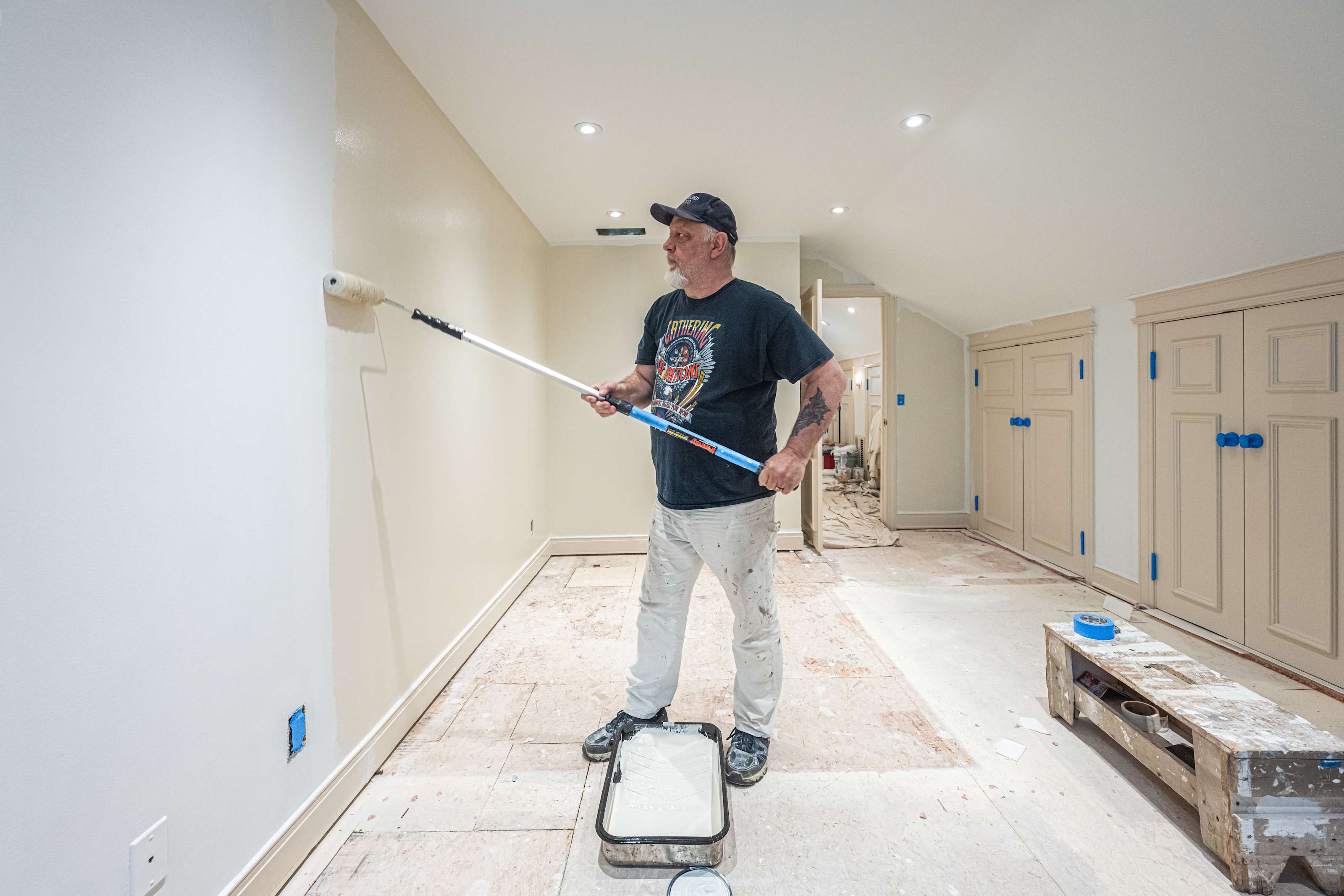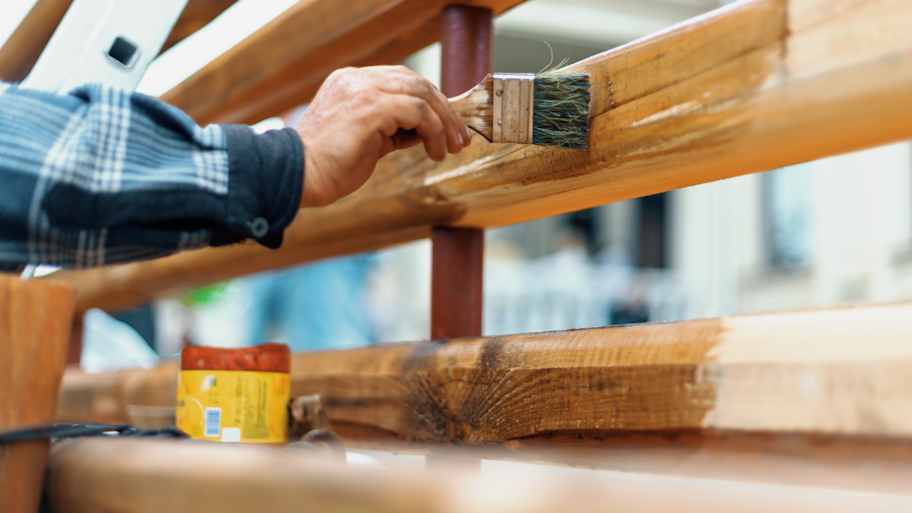
Wondering about the cost to chalk paint furniture? Learn prices, key cost factors, and tips to help you budget for your next furniture makeover.
Find out the meaning behind all the talk about VOCs


VOCs are volatile organic compounds that cause health concerns.
VOCs can linger in the air and affect indoor air quality.
Low-VOC paints still have small amounts of VOCs.
No-VOC paints are the safest option but are duller in color and harder to apply.
Unlike that new-car smell, the smell of a fresh paint job isn’t an enjoyable sensory experience. What you’re smelling are volatile organic compounds, also known as VOCs, which are chemicals released into the air as paint dries. Along with the unpleasant hit to the nostrils, VOCs can negatively impact human health and the environment.
Low-VOC and no-VOC (or zero-VOC) paints contain lower levels of these harmful chemicals than traditional paints, but the benefits don’t end there. Here are the top advantages of using no-VOC and low-VOC paints.
VOCs are toxic chemicals that vaporize at room temperature through a process known as outgassing. As paints outgas these compounds, it creates that powerful “new paint” smell that can really aggravate the senses. What’s more, these VOCs also negatively impact indoor air quality and can lead to a number of health conditions.
According to the Environmental Protection Agency (EPA), health concerns include:
Headaches
Nausea
Respiratory problems
Stinging or watery eyes
Blurred vision
Aggravated asthma symptoms
While these toxic emissions were more prominent in previous decades, increased awareness of their harmful effects has led many manufacturers to improve the formulas of their paints for lower VOC content. Even still, it’s important to read product labels or consult a professional painter for advice.
Oil-based paints contain higher volatile organic compounds (VOCs) than latex paints. To limit your exposure to VOCs while painting indoors, keep the area well-ventilated, wear respiratory protection, and avoid the painted area for at least 72 hours once finished.
| No-VOC Paint | Low-VOC Paint |
|---|---|
| Safest paint option | Safer than high-VOC paint |
| Most environmentally friendly | Creates some emissions |
| Harder to apply | Easier to apply |
| Less vibrant | Brighter, richer colors |
| Least odor | Low odor |
| Higher cost than low-VOC paint | Higher cost than standard paint |
| Standard longevity | More longevity |
Both low-VOC and zero-VOC paints are designed to reduce the levels of harmful chemicals that get released into the air after a fresh coat of paint. Low-VOC paints contain lower levels of these chemicals, while no-VOC paints have none at all, opting for natural alternatives such as clay and chalk. Here’s how these two types of paint compare.
Low-VOC paint still contains some VOCs, though these are at much lower levels than traditional paint. While these low levels of VOCs are generally considered safe, they can still cause some health problems in sensitive individuals, especially if the paint is applied in a poorly ventilated space. Since No-VOC paints are completely free of these chemicals, they’re the safest option for human health.
According to the EPA, when people use products containing harmful organic chemicals, elevated concentrations of pollutants in the air can linger in the air long after the project is completed. While low-VOC paints have far fewer harmful emissions than traditional paints, they still contain a small amount that gets outgassed into the air during the paint job. With that in mind, no-VOC paints are the more eco-friendly choice between the two.
While they’re easier on the nose, no-VOC paints are generally more challenging to work with than low-VOC paints. This is because they’re usually more difficult to spread into a smooth, even layer. In general, it’s best to hire an experienced local painter to handle jobs with low- or no-VOC paints.
A key tradeoff between low-VOC paint and no-VOC paint is appearance. Low-VOC paints will have brighter, richer hues than no-VOC paints. Since no-VOC paints are limited in the ingredients they can contain, colors often aren’t as vibrant as their low-VOC counterparts.
Both low-VOC and no-VOC paints offer a much lower odor output than traditional paints. Since no-VOC paints have no volatile organic compounds, they have even less of an odor than low-VOC paint. No matter which product you choose, though, it’s still important to open windows and use fans for optimal ventilation while you paint.
If you’re budgeting for the cost to paint the interior of a house, you’ll need to put extra aside if you’re opting for low-VOC or no-VOC paints. While both varieties tend to be more expensive than traditional paint, no-VOC paints are typically pricier than low-VOC paints.
Low-VOC paint is known for its long-lasting color. Traditional paint can fade over time, especially if it is exposed to direct sunlight. Low-VOC paint, on the other hand, is designed to maintain its color for longer periods of time.
When shopping for paint, it can be tricky to know what kind and how much paint you need. While so many options can make for a difficult decision, this doesn’t mean that variety is unwelcome.
Luckily, many of the best paint brands are starting to carry low-VOC and no-VOC varieties of paint, with greater transparency on the VOC content of their products. You’ll likely find more options for low-VOC paints, but the selection is growing either way.
Low-VOC and no-VOC paints are available in a wide range of finishes and formulations, so you’ll be able to find options for most of your painting projects.
No-VOC and low-VOC paints are often found in water-based formulations. Brands like ECOS and Clare offer no-VOC water-based paints in a variety of colors and finishes. Water-based paint is easy to clean, durable, and relatively easy to apply.
For those who prefer the coverage and durability of acrylic paint, paints like Benjamin Moore®’s Eco Spec or Behr®’s Premium Plus Low Odor offer the benefits of acrylic paint with the bonus of a no-VOC formula. No-VOC and low-VOC acrylic paints are becoming common with larger paint manufacturers and can be mixed to achieve an almost endless array of colors.
The health and environmental aspects are certainly beneficial, but they come at a higher cost.
Earth-friendly: Low-VOC paint is friendlier to the environment because it releases fewer volatile compounds into the atmosphere, which can harm not only our lungs but the health of plants and wildlife and the stability of the climate.
Less odor: Everyone knows that “freshly painted” smell. Using low-VOC paints lessens the power of that unfortunate scent and the time it takes for a painted room to off-gas and clear the air.
Safer for you: Ever feel like you can’t breathe properly in a freshly painted room or during a painting project? That’s thanks to the toxic fumes put out by VOCs in paint. It’s easy to imagine why low-VOC paint would be much easier on your lungs.
Higher price: Like organic food at the grocery store, higher quality paint comes with a higher price tag than traditional paint. Crunch the numbers before you get to the cash register to help prepare yourself and your budget.
Additional chemicals: Unfortunately, VOCs aren’t the only chemicals in paint. Additional solvents and chemicals used in making paints could also pose a threat to your health if you don’t do your research first.
From average costs to expert advice, get all the answers you need to get your job done.

Wondering about the cost to chalk paint furniture? Learn prices, key cost factors, and tips to help you budget for your next furniture makeover.

Wondering about the cost to paint a fireplace? Get a detailed guide to prices, key factors, and money-saving tips for your fireplace painting project.

How much does it cost to paint a room? Learn what you’ll pay to give your space a makeover, depending on room size, paint type, the pro you hire, and more.

Trying to decide between oil-based and water-based stain? Learn the pros, cons, and best uses to find the right finish for your next wood project.

Refinishing stairs is a great way to spruce up one of a home's most dominant focal points. High-quality wood should be allowed to shine. Learn the cost to refinish stairs in this guide.

When selecting the best paint for garage walls and ceilings, consider aesthetics, durability, ease of cleaning, and conditions in the space.